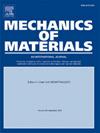Mechanism and prediction of screw dislocation strengthening by interstitials in advanced high-strength steels: Application to Fe–C and Fe–N alloys
IF 3.4
3区 材料科学
Q2 MATERIALS SCIENCE, MULTIDISCIPLINARY
引用次数: 0
Abstract
Screw dislocations control the yield strength of low-alloyed body-centered-cubic (e.g. steels). Interstitials such as C and N play a key role in the strengthening mechanisms, yet a mechanistic theory that enables the prediction of strength of alloys over a broad range of compositions and interstitial contents is not available. Here, we provide such a theory and apply it to screw dislocations with C and N in iron, from dilute to larger concentrations. The theory, which accounts for interstitial solute segregation by Cottrell atmospheres, is validated with respect to atomistic simulations and used to predict the yield strength of a broad range of alloys, including fully ferritic, martensitic and precipitation-strengthened microstructures. By using a recent model developed by the authors to predict the dislocation density of martensite as a function of the interstitials content, we find a new scaling of the yield strength with the dislocation density, which matches experiments and differs from the commonly used Taylor equation. The demonstrated predictive power of the theory paves the way for theory-guided alloy design, based on reduced and hence more sustainable testing.
高级高强钢中间隙强化螺位错的机理及预测:在Fe-C和Fe-N合金中的应用
螺位错控制低合金体心立方(如钢)的屈服强度。像C和N这样的间隙在强化机制中起着关键作用,然而,能够在广泛的成分和间隙含量范围内预测合金强度的机制理论还没有得到。在这里,我们提供了这样一个理论,并将其应用于铁中C和N的螺旋位错,从稀释到较大浓度。该理论解释了Cottrell气氛造成的溶质间偏析,并通过原子模拟得到了验证,并用于预测各种合金的屈服强度,包括全铁素体、马氏体和沉淀强化显微组织。利用作者最近建立的预测马氏体位错密度随间隙含量变化的模型,我们发现了一种新的屈服强度随位错密度的标度,它与实验结果相符,不同于常用的泰勒方程。该理论的预测能力为理论指导的合金设计铺平了道路,基于减少和因此更可持续的测试。
本文章由计算机程序翻译,如有差异,请以英文原文为准。
求助全文
约1分钟内获得全文
求助全文
来源期刊

Mechanics of Materials
工程技术-材料科学:综合
CiteScore
7.60
自引率
5.10%
发文量
243
审稿时长
46 days
期刊介绍:
Mechanics of Materials is a forum for original scientific research on the flow, fracture, and general constitutive behavior of geophysical, geotechnical and technological materials, with balanced coverage of advanced technological and natural materials, with balanced coverage of theoretical, experimental, and field investigations. Of special concern are macroscopic predictions based on microscopic models, identification of microscopic structures from limited overall macroscopic data, experimental and field results that lead to fundamental understanding of the behavior of materials, and coordinated experimental and analytical investigations that culminate in theories with predictive quality.
 求助内容:
求助内容: 应助结果提醒方式:
应助结果提醒方式:


